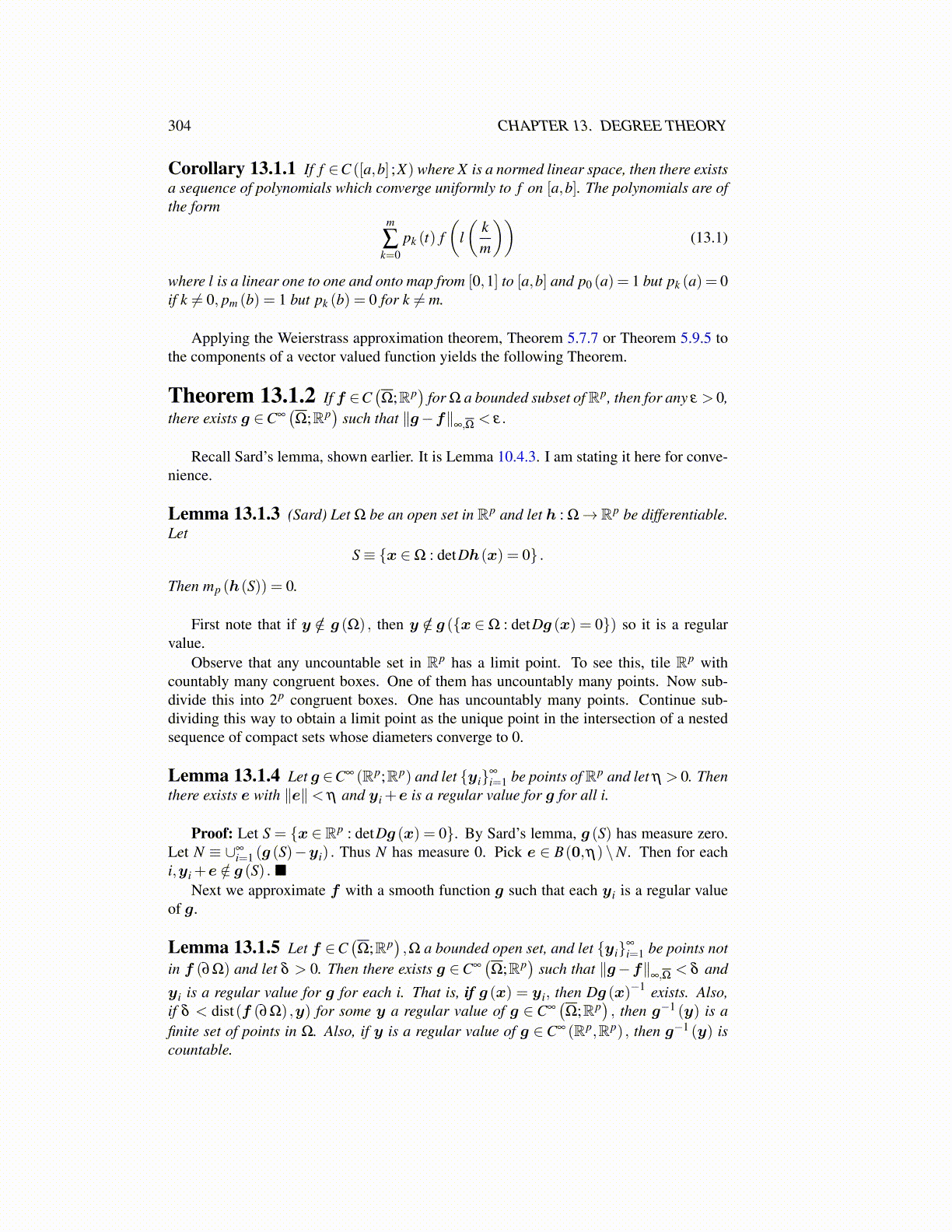
304 CHAPTER 13. DEGREE THEORY
Corollary 13.1.1 If f ∈C ([a,b] ;X) where X is a normed linear space, then there existsa sequence of polynomials which converge uniformly to f on [a,b]. The polynomials are ofthe form
m
∑k=0
pk (t) f(
l(
km
))(13.1)
where l is a linear one to one and onto map from [0,1] to [a,b] and p0 (a) = 1 but pk (a) = 0if k ̸= 0, pm (b) = 1 but pk (b) = 0 for k ̸= m.
Applying the Weierstrass approximation theorem, Theorem 5.7.7 or Theorem 5.9.5 tothe components of a vector valued function yields the following Theorem.
Theorem 13.1.2 If f ∈C(Ω;Rp
)for Ω a bounded subset ofRp, then for any ε > 0,
there exists g ∈C∞(Ω;Rp
)such that ∥g−f∥
∞,Ω < ε.
Recall Sard’s lemma, shown earlier. It is Lemma 10.4.3. I am stating it here for conve-nience.
Lemma 13.1.3 (Sard) Let Ω be an open set in Rp and let h : Ω→Rp be differentiable.Let
S≡ {x ∈Ω : detDh(x) = 0} .
Then mp (h(S)) = 0.
First note that if y /∈ g (Ω) , then y /∈ g ({x ∈Ω : detDg (x) = 0}) so it is a regularvalue.
Observe that any uncountable set in Rp has a limit point. To see this, tile Rp withcountably many congruent boxes. One of them has uncountably many points. Now sub-divide this into 2p congruent boxes. One has uncountably many points. Continue sub-dividing this way to obtain a limit point as the unique point in the intersection of a nestedsequence of compact sets whose diameters converge to 0.
Lemma 13.1.4 Let g ∈C∞ (Rp;Rp) and let {yi}∞
i=1 be points ofRp and let η > 0. Thenthere exists e with ∥e∥< η and yi +e is a regular value for g for all i.
Proof: Let S = {x ∈ Rp : detDg (x) = 0}. By Sard’s lemma, g (S) has measure zero.Let N ≡ ∪∞
i=1 (g (S)−yi) . Thus N has measure 0. Pick e ∈ B(0,η) \N. Then for eachi,yi +e /∈ g (S) . ■
Next we approximate f with a smooth function g such that each yi is a regular valueof g.
Lemma 13.1.5 Let f ∈C(Ω;Rp
),Ω a bounded open set, and let {yi}
∞
i=1 be points notin f (∂Ω) and let δ > 0. Then there exists g ∈C∞
(Ω;Rp
)such that ∥g−f∥
∞,Ω < δ and
yi is a regular value for g for each i. That is, if g (x) = yi, then Dg (x)−1 exists. Also,if δ < dist(f (∂Ω) ,y) for some y a regular value of g ∈ C∞
(Ω;Rp
), then g−1 (y) is a
finite set of points in Ω. Also, if y is a regular value of g ∈C∞ (Rp,Rp) , then g−1 (y) iscountable.